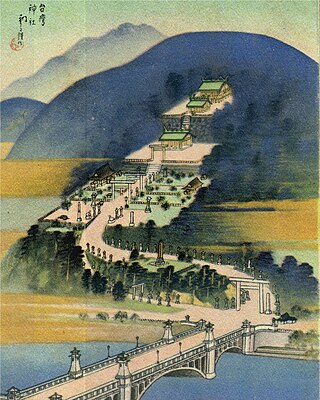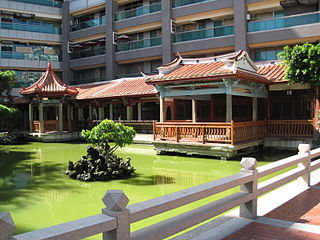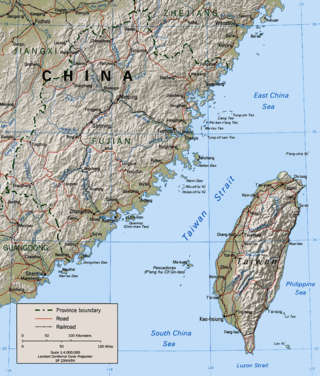| |||||
| Decades: | |||||
|---|---|---|---|---|---|
| See also: | Other events of 1920 History of Taiwan • Timeline • Years | ||||
Events from the year 1920 in Taiwan, Empire of Japan.
| |||||
| Decades: | |||||
|---|---|---|---|---|---|
| See also: | Other events of 1920 History of Taiwan • Timeline • Years | ||||
Events from the year 1920 in Taiwan, Empire of Japan.
11 January – Fouding of the New People Society. [1] [2]

The Taiwan Grand Shrine was the highest ranking Japanese Shinto shrine in Taiwan during Japanese colonial rule. It was located in Taihoku, Taiwan. Among the officially sanctioned Shinto shrines in Taiwan, Taiwan Grand Shrine held the highest rank of them all. The Grand Hotel stands at the shrine's former site.
The New Peoples' Society was established on 11 January 1920. It was the first organization for political movement, created by Taiwanese students in Japan during the Japanese rule of Taiwan.
Chen-Yuan Lee, was a Taiwanese pharmacologist and political activist. He is famous for his research on snake venom. He was a recipient of the prestigious Redi Award from the International Society on Toxinology (IST), and was also a former president of the society. He was a former dean of the National Taiwan University College of Medicine. After his retirement from researching, he focused on participating in the Taiwan independence movement and many democratic movement. Lee had founded many political organizations such as the "100 Action Union" (100行動聯盟), Foundation of Medical Professionals Alliance in Taiwan. He was also the first chairperson of the Taiwan Independence Party.

The Seediq are a Taiwanese indigenous people who live primarily in Nantou County and Hualien County. Their language is also known as Seediq.

Jack C.K. Teng, was a Chinese educator, writer, politician, diplomat and Olympic pioneer. He is best known as the Chairman of the Chinese National Olympic Committee during the 1960 Summer Olympics, the first time a Chinese athlete won an Olympic medal.

Tainan Wu Garden, known at the time of its creation as "Purple Spring Garden (紫春園)," is located in West Central District, Tainan, Taiwan. Built by Wu Shangxin (吳尚新), the garden is known as one of the Four Great Gardens of Taiwan (台灣四大名園), along with Lin Family Mansion and Garden in Wufeng (霧峰萊園), Beiguo Garden in Hsinchu (新竹北郭園), and Lin Family Mansion and Garden in Banqiao (板橋林本源園邸),.

The Petition Movement for the Establishment of a Taiwanese Parliament took place in the first half of the twentieth century. It demanded that the Imperial Diet of Japan establish a self-governing parliament, or representative assembly, in Taiwan. Started by New People Society of Taiwan, this movement marked a transition in Taiwanese colonial politics, from armed resistance to modern political movement. It was the longest political movement during the Japanese occupation period of Taiwan..

Literary Day is observed annually on May 4 in Taiwan, in honor of the May Fourth Movement. It was first celebrated on this day in 1945, and its establishment was affected by the dispute over whether the Kuomintang or the Communist Party was the legitimate successor to the May Fourth Movement, disagreements about how to interpret the movement, and other cultural struggles.

Hokutolite is the only mineral named after a Taiwanese place among the more than 4,000 naturally occurring minerals in the world. Hokutolite is a rare mineral containing radioactive radium elements generated by the hot spring environment, and is currently found only in Beitou Hot Spring in Taipei City, and Tamagawa Hot Spring in Akita Prefecture, Japan. In Japan, the Ministry of Education, Culture, Sports, Science, and Technology has designated it as a "Special Natural Monument". In Taiwan, it is designated as a "Natural Cultural Landscape", and the Taipei City Government has designated a natural reserve in the Beitou River upstream of the Beitou Hot Spring Museum.

Si̍t-chûn Movement, inasmuch as the Kyoto School, Neo-Confucianism and other prominent philosophical movements in the early-twentieth-century East Asia, is a significant philosophical movement during the Japanese colonial rule in Taiwan, in which the intellectuals in the 1920s formulated their reflections on the Taiwanese community through the western values and thoughts and wedged against the colonial domination and imperial assimilation. Si̍t-chûn Movement was intensely bond with political and cultural counter-imperialism, involving intellectuals e.g. Lin Mosei(zh:林茂生), Hung Yao-hsün(zh:洪耀勳), Wen Kwei Liao(zh:廖文奎), Mingdian Liu(zh:劉明電), Shao-Hsing Chen(zh:陳紹馨), Lin Qiu-wu(zh:林秋悟), Hsiang-yu Su(zh:蘇薌雨), Shenqie Zhang(zh:張深切), Chin-sui Hwang(zh:黃金穗), Shoki Coe(zh:黃彰輝), Isshū Yō(zh:楊杏庭), C K Wu(吳 振坤), and so forth. 'At the begin,' according to the Taiwanese cultural sociologist Ren-yi Liao 's 1988 grounding formulation, 'Taiwanese Philosophy has been a civil intellectual movement against domination, rather than an academic form of conception.' 'Si̍t-chûn Movement', however, has yet ratified and systemically studied until 2014.

Philosophy in Taiwan is the set of philosophical traditions in Taiwan, while Taiwanese philosophy is taken to mean philosophical work from the country. Philosophical thought in Taiwan is diverse, drawing influence from Chinese philosophy during Qing rule from the 17th and 18th century, and Western philosophy through the Kyoto School during Japanese rule in the 19th and early 20th century. Taiwanese philosophy took a more endogenous turn during the modern era, with burgeoning philosophical debate regarding Taiwanese Gemeinschaft.

The Fujian–Taiwan relations, also known as the Min–Tai relations, refers to the relationship between Fujian, which is located in mainland China, and Taiwan, which is across the Taiwan Strait. Since the average width of the Taiwan Strait is 180 kilometers, Fujian and Taiwan are adjacent, similar in both climate and environment. Although the relationship between Taiwan and Fujian has changed with the development of history, the two places have maintained close relations in terms of personnel, economy, military, culture and other aspects. At present, Taiwan residents are mostly descendants of immigrants from mainland China, of which the southern Fujian ethnic group is the main group, accounting for 73.5% of Taiwan's total population. In terms of culture, language, religion, and customs, Fujian and Taiwan also share similarities.

The Organization for the Support of Democratic Movement in Taiwan (OSDMT) was a Chinese-American student-led organization which promoted democracy in Taiwan.

Washington DC Taiwanese School is a Taiwanese-American nonprofit organization that was established in 1983. The school offers classes on Sunday afternoons at Cabin John Middle School in Potomac, MD, with a curriculum focused on language learning, cultural immersion, and community engagement.
In Taiwan, the performing arts are typically classified into the broad categories of music, dance, drama, and traditional opera, with further subdivisions within each category. For instance, traditional opera includes Taiwanese opera, Peking opera, glove puppetry, Beiguan opera, Hakka opera, and others, while dance includes folk dance, modern dance, and indigenous dance. Some genres are difficult to categorize, such as circus acts, immersive experiences, and magic, and some are classified as "integrated art" or included in one of the above listed categories.

Local elections were held in Taiwan on 21 April 1957, the third nation-wide elections in post-war Taiwan, electing all 21 mayors of cities and magistrates of counties with a three-year tenure. Fuchien Province, then under military administration, was not up for election. Election for Provisional Taiwan Provincial Council was held alongside the local elections to elect 66 councillors.
The history of Cross-Strait relations introduces the historical changes in the relationship between China and Taiwan since the beginning of time. Suspected records of Taiwan in the history of China date back to the earliest times, when Yizhou (island) was mentioned in the "Three Kingdoms", or Liuqiu in the "Book of Sui". During the Song dynasty and Yuan dynasties, there was trade between the two sides of the Strait, and in 1281, Kublai Khan established the Penghu Inspection Division, which began to exercise administrative jurisdiction over Penghu. In 1349, Wang Dayuan documented in Island Yi Zhi Lu that Penghu belonged to Jinjiang County, Quanzhou, and that Liuqiu was one of the overseas countries. The "Dongfan Ji", written by Chen Di in the Ming Dynasty, depicts the customs of the aborigines in southwest Taiwan. Since the 1620s, cross-strait relations have been influenced by the Dutch, the Spanish, the Han Chinese, the Manchus, and the Japanese, and mainland China and Taiwan have either unified or separated, with ups and downs.
The Sakuma Foundation's Indigenous Artifacts Collection Project was a large-scale systematic acquisition program for the collection of artifacts of the indigenous peoples in Taiwan under Japanese rule. Between 1927 and 1929, the Sakuma Foundation was responsible for funding the acquisition of 1,760 artifacts from Taiwanese indigenous peoples, which were acquired by the Indigenous Pacification Section of the Department of Police of the Government-General of Taiwan.

Jiao, also known as Jiaoshang, Hangjiao, and also known as Dingshou and Jiu Baxing, was a commercial guild organization that spread throughout Taiwan during the Qing Dynasty. The members of the organization were mostly ship merchants or merchants who settled in ports. In the middle of the Qing Dynasty, the commercial function of Jiao was gradually declining due to the sedimentation